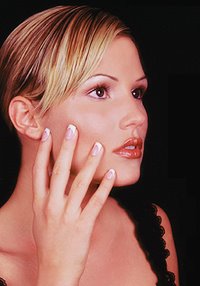
A lack of zinc and iron can make them brittle, says the nutritionist.
If one has terrible nails — they peel constantly, break and are quite soft. Nothing you have ever done has helped, not even a pregnancy. You try to eat as healthily as possible and include lots of dairy in your diet as well as lean meat, chicken and fish. What could you do that will improve their condition?
Brittle nails are often thought to be the result of calcium deficiency, but in fact the nail contains very little calcium and the problem is more likely to be caused by lack of zinc. Meat, shellfish, fish,crumbly cheese and eggs are all good sources of this mineral. While wholemeal bread, wholegrain cereals, nuts, seeds like pumpkin, and certain vegetables, eg, courgettes, marrow and asparagus, also contain zinc, these foods unfortunately also contain phytates, which reduce zinc absorption. Many women are unaware that taking the Pill can also affect the amount of zinc taken in by the body. As a lack of zinc can lower your libido, this may explain why some women say that they lose interest when they are on the Pill. (The same effect on zinc levels and libido can be observed with long-term use of the antibiotic tetracycline, which is used as a treatment for acne.) So the first step is to boost your intake of zinc-rich foods. It is also worth finding out if you have an iron deficiency. This can be pretty common after pregnancy, as your baby will have been draining your reserves. A lack of iron can cause iron deficiency anaemia: the symptoms include feeling tired (although with a baby, who doesn’t?), looking pale and brittle nails. Your doctor can do a simple blood test to check your levels of haemoglobin (the pigment in the blood that carries iron around the body) and your body’s store of iron, or ferritin levels. Incidentally, low ferritin levels also account for many women losing their hair. Increase the amount of iron-rich foods in your diet — this means lean red meat,liver,eggs, green leafy vegetables, pulses, lentils and dried apricots. Eating vitamin C-rich foods at the same time will help to ensure that your body absorbs plenty of iron (good sources of vitamin C include berries, oranges and kiwi fruit).Caffeine interferes with iron absorption, so try to avoid having it with meals. Also avoid excess alcohol, as brittle nails may, in extreme cases, be a sign of an unhealthy liver — though I doubt that this is true for you. I think that the main problem is that your pregnancy has drained you of your zinc and iron stores. And finally, many people have little white flecks on their nails — this can be a sign that the nail has received a knock, but it may be worth looking at your zinc intake, too.




























